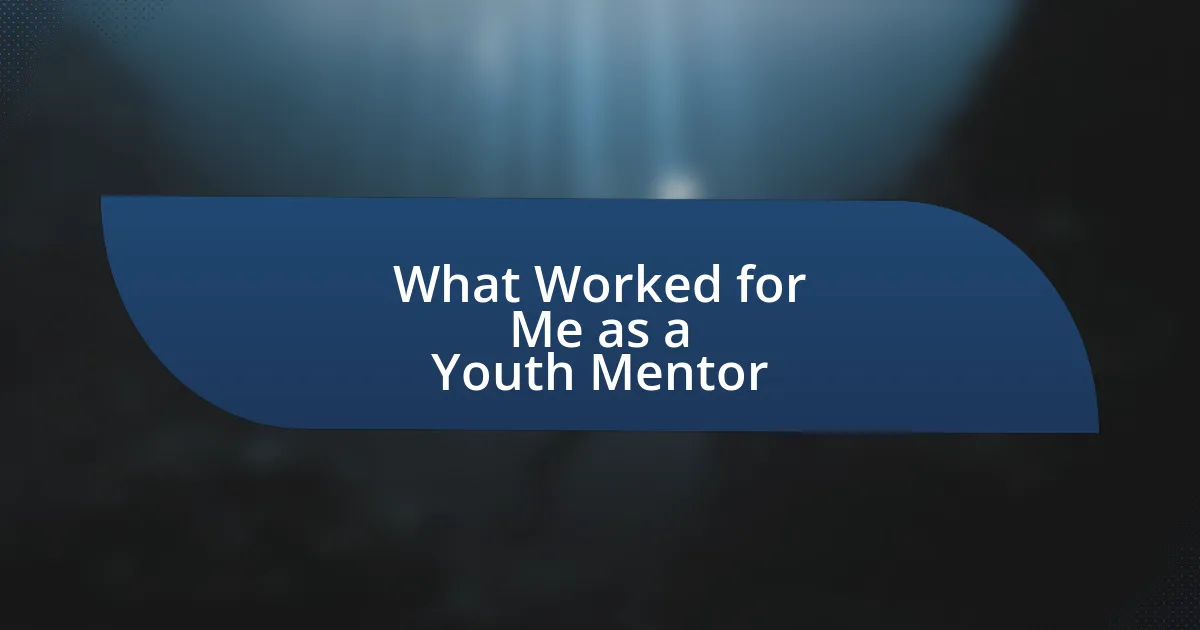Key takeaways:
- Inclusion is about valuing every student and fostering connections through meaningful engagement and cultural celebrations.
- Identifying barriers, such as social exclusion and intimidating physical environments, is crucial for creating an inclusive school space.
- Continuous training for staff on inclusivity helps combat biases and enhances understanding of students’ diverse experiences.
- Monitoring and celebrating diversity through events fosters community, reinforces belonging, and highlights the importance of every student’s story.
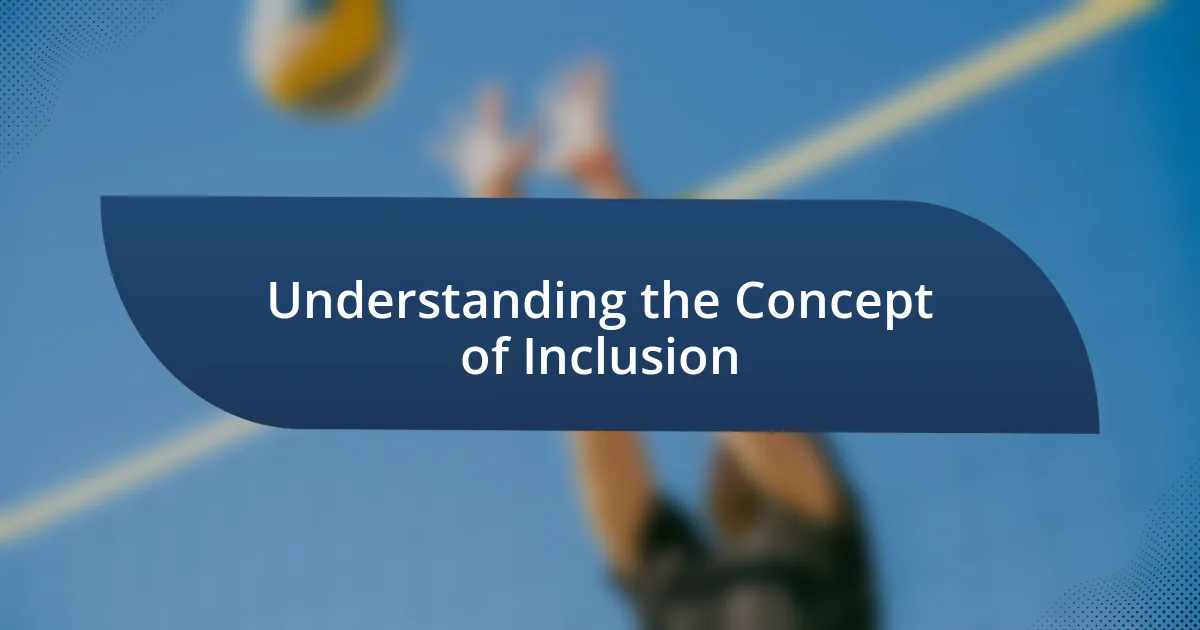
Understanding the Concept of Inclusion
Inclusion, at its core, means ensuring that every student feels valued and has a place within the school community. I remember a time when a new student joined our class, and I noticed how quiet and withdrawn they were. How often do we miss the chance to reach out to those who might feel isolated?
When I reflect on inclusion, I think about the diverse backgrounds and abilities that each student brings into the classroom. For instance, I once led a project where we celebrated cultural diversity, and it was incredible to see students share their stories. This kind of environment not only fosters understanding but enriches everyone’s learning experience.
Inclusion is not just about physical presence; it’s about actively engaging every student in meaningful ways. I often ask myself: Are we really hearing each voice in our classrooms? Sharing thoughts fosters connection, leading to an atmosphere where all students can thrive, no matter their challenges.

Identifying Barriers to Inclusion
Identifying barriers to inclusion requires keen observation and an understanding of the unique dynamics at play in a school environment. One day, while helping students during recess, I noticed a group of children reluctant to include their classmate, who often struggled with communication. It struck me—sometimes, barriers are invisible, and they manifest as unintentional social exclusions. How do we address these subtle yet powerful forces that can affect a child’s school experience?
In my experience, physical spaces can also hinder inclusion. I recall a time when our library’s layout seemed to intimidate some students, making it hard for them to engage comfortably with peers or staff. This realization pushed me to advocate for a more welcoming environment where students could gather freely. Creating inclusive spaces isn’t just about addressing needs; it’s about fostering connections that empower every student to feel they belong.
Understanding these barriers takes time but it leads to valuable insights. For example, through discussions with students, I discovered that some felt hesitant to participate in group activities due to previous negative experiences. This feedback helped me realize the importance of empathy and a supportive atmosphere. Sharing these stories amongst peers often sparked meaningful conversations about challenges we all face, shifting our approach from a deficit mindset to one of collaboration and support.
| Type of Barrier | Example |
|---|---|
| Social Exclusion | Students not including peers with different communication styles |
| Physical Environment | Outdated or intimidating library layout |
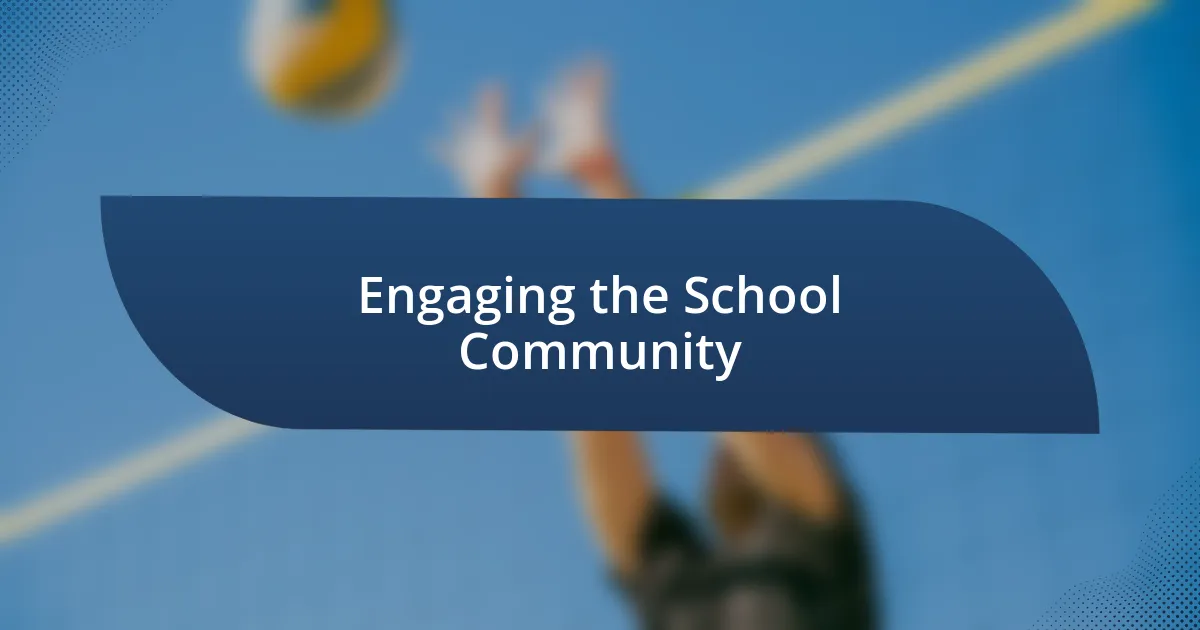
Engaging the School Community
Engaging the entire school community was a game-changer for fostering inclusion. I vividly remember the first time I organized a “Diversity Day” event, where everyone was invited to share their cultures, traditions, and stories. Watching students come together, sharing laughter and insights, truly illuminated the rich tapestry of our community. It wasn’t just an event; it was a celebration that transformed perceptions and built connections.
To sustain that momentum, I recognized the importance of ongoing communication. Here are a few strategies that helped to keep everyone involved:
- Regular Workshops: Monthly workshops on inclusion helped build a common language and understanding among students and staff.
- School Newsletters: Featuring stories of inclusion, showcasing students’ achievements, and celebrating diversity through the school’s newsletter.
- Feedback Channels: Establishing anonymous channels for students and parents to voice concerns and ideas about fostering inclusion helped create a sense of ownership among the community.
- Inclusive Committees: Forming student-led committees to plan events ensured diverse perspectives were represented, giving students a platform to share their voices.
These initiatives breathed life into the notion of inclusion, demonstrating that when the whole school community collaborates, the results can be transformative.
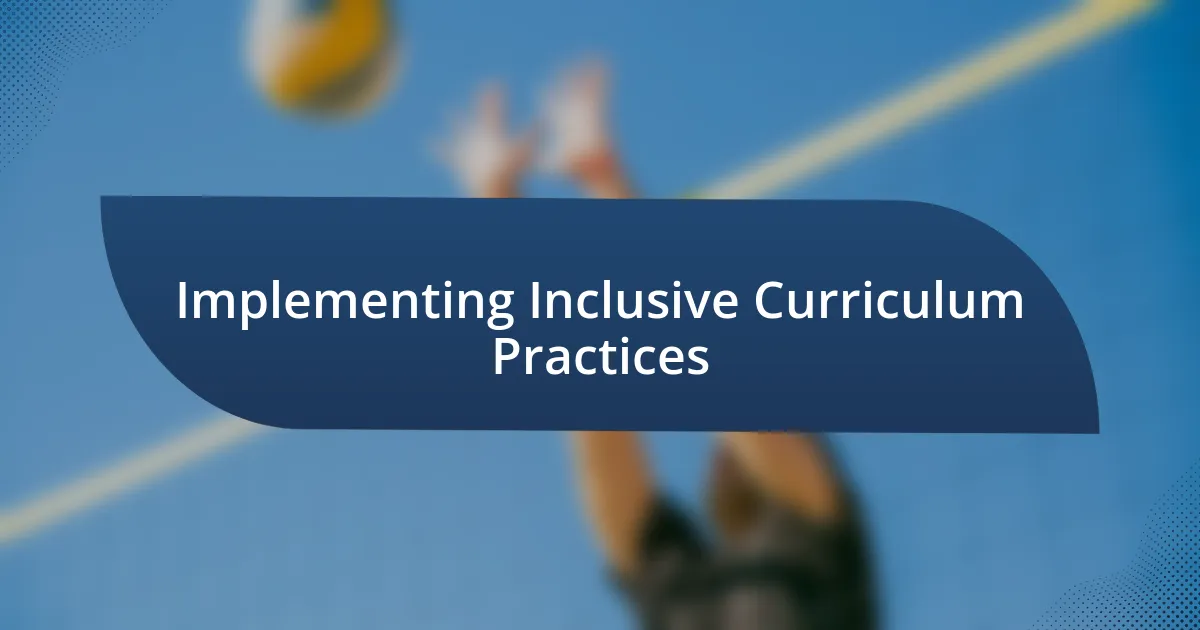
Implementing Inclusive Curriculum Practices
Implementing inclusive curriculum practices was a crucial step in my journey toward fostering inclusion. I remember how excited I was to introduce a literature module that included diverse authors from various backgrounds. It wasn’t just about reading; it was about discussing experiences and perspectives that many students found relatable, sparking a deeper engagement and understanding among peers.
One day, while facilitating a discussion on a book by a minority author, I noticed a student who usually sat quietly in the back, suddenly raise their hand. They shared a personal experience that mirrored the book’s themes, and it was a moment of connection that I knew we had to do more of. How often do we miss these opportunities to validate students’ lived experiences? By implementing inclusive readings, I saw students not only recognize their own stories in literature but also develop empathy for classmates from different backgrounds.
Additionally, I learned the power of integrating flexibility into lesson plans to cater to various learning styles. For example, when discussing complex concepts, I started using visual aids and group activities that allowed students to collaborate. It became apparent to me that when I tailored my teaching to accommodate individual needs, everyone flourished. This approach reinforced my belief that an inclusive curriculum is not just about content—it’s about doing the necessary work to ensure every student feels seen and valued in their learning journey.

Training Staff on Inclusivity
Training staff on inclusivity was one of the most vital aspects of fostering a welcoming environment in my school. I vividly recall a professional development workshop we held, where I watched educators grapple with their biases and assumptions. As the facilitator guided us through exercises that challenged our perspectives, I couldn’t help but think: How often do we pause to reflect on our own impact in the classroom? This experience was not only enlightening but also a reminder of the importance of continuous personal growth.
In one session, we shared stories of students who had been marginalized or overlooked. I shared a heartfelt account of a student whose talents in art had often been dismissed. As I spoke, I saw tears in the eyes of some colleagues, indicating their realization of the importance of recognizing every student’s potential. It struck me that by sharing these experiences, we fostered empathy and drove home the message that inclusivity isn’t a checklist—it’s about creating connections and understanding one another’s journeys.
We also implemented role-playing scenarios to practice inclusive interactions. I remember stepping into the shoes of a student who had experienced bullying due to their identity. The discomfort I felt during that exercise was palpable; it reinforced how critical it is to be sensitive and responsive. I often think back to that feeling and ask myself: Are we, as educators, truly listening to our students’ voices? This training ignited a passion in our staff to commit not only to awareness but also to real action in supporting every child in our school community.
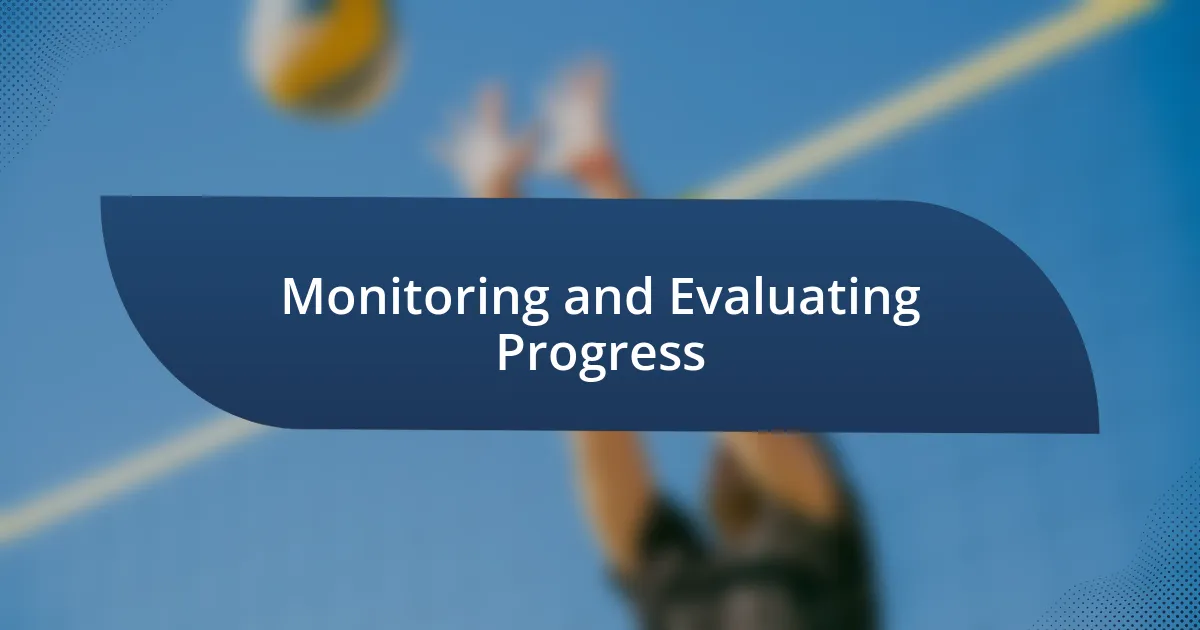
Monitoring and Evaluating Progress
Monitoring and evaluating the progress of inclusivity initiatives in my school was a continuous journey rather than a one-time task. I remember sitting down with a small team to examine feedback from our recent inclusivity workshops. Seeing the positive impact on our students through their increased participation really made me consider: How often do we celebrate these small wins that signify a step towards greater acceptance?
One particular moment stands out to me. We implemented a simple system for students to voice their experiences anonymously. After reading some of those letters, I felt a mix of emotions—joy at the positive stories and sadness at the challenges they faced. It made me realize that monitoring isn’t just about collecting data; it’s about truly understanding the lived experiences of our students. Are we asking the right questions to uncover the deeper issues?
As the months went by, we adjusted our strategies based on what we learned from our evaluations. I recall an instance when we recognized a lack of representation in our school literature. Actively seeking diverse voices not only enriched our curriculum but also fostered a sense of belonging among our students. This experience taught me the power of adaptability—how crucial it is to listen, reflect, and change course when necessary to ensure every student feels valued and included.
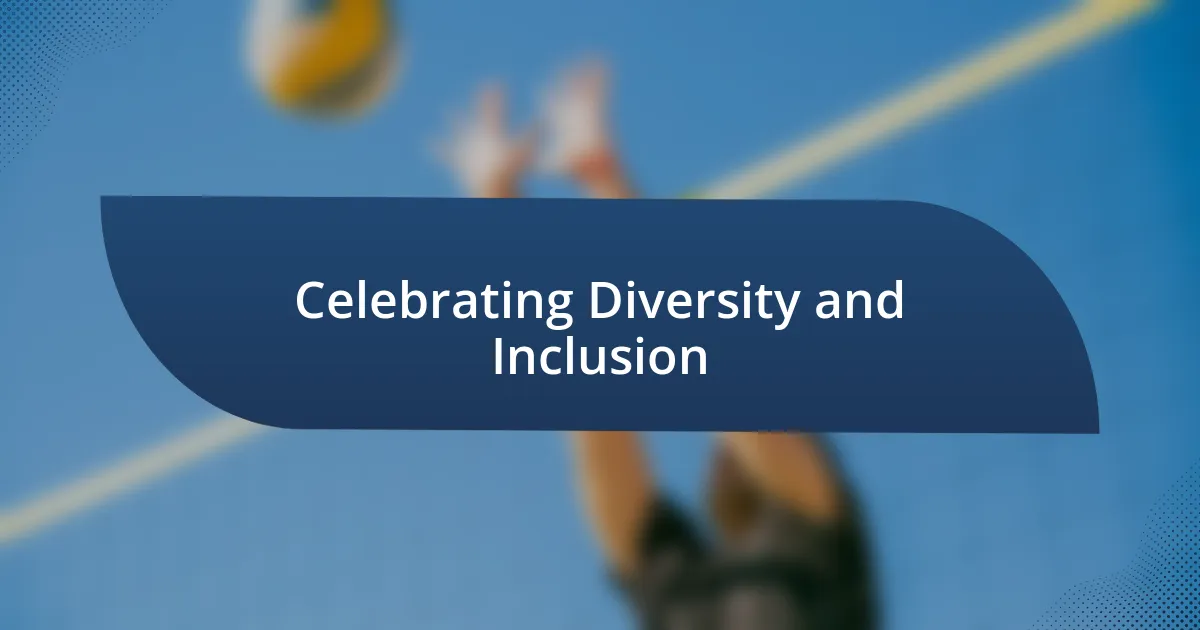
Celebrating Diversity and Inclusion
Celebrating diversity in my school has always been a heartfelt endeavor. During our cultural appreciation week, I remember a student sharing a personal story about her family’s traditions. Listening to her, I felt a surge of pride for our community’s tapestry of backgrounds. How often do we miss the chance to honor individual stories that enrich our shared experience?
I also think back to our annual diversity fair. It was truly a vibrant mosaic of food, music, and art from various cultures. As I watched students eagerly sample dishes and participate in dances, I felt an overwhelming sense of connection among us. Wasn’t it incredible how a simple celebration could break down barriers and foster friendships?
Each event reinforced something essential: diversity isn’t just about difference but about belonging. When I see students coming together, celebrating their unique backgrounds, I’m reminded that inclusion starts with recognizing and valuing those differences. How can we create more spaces that nurture this sense of community?



